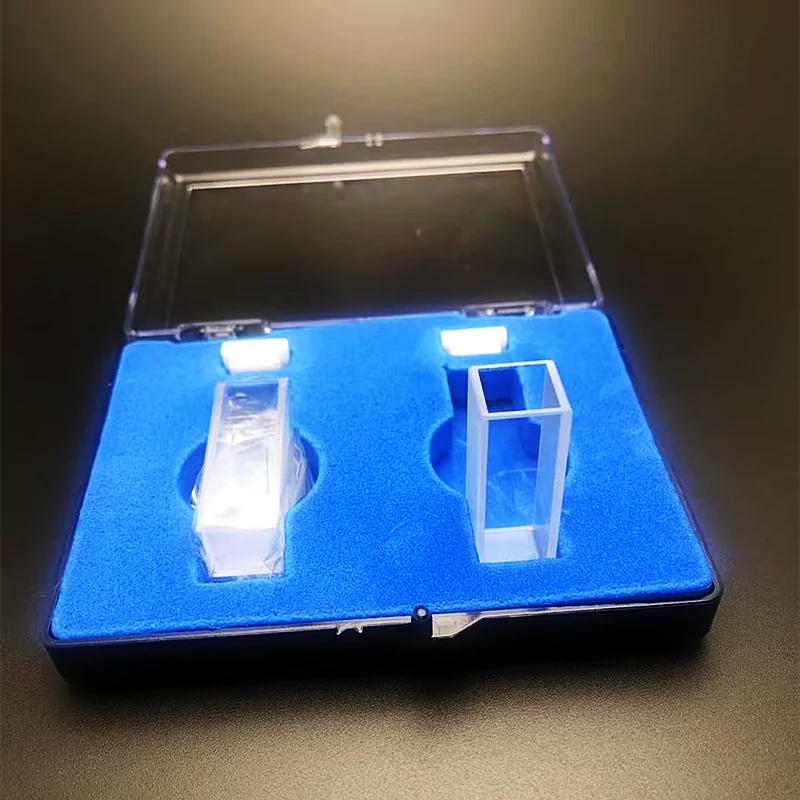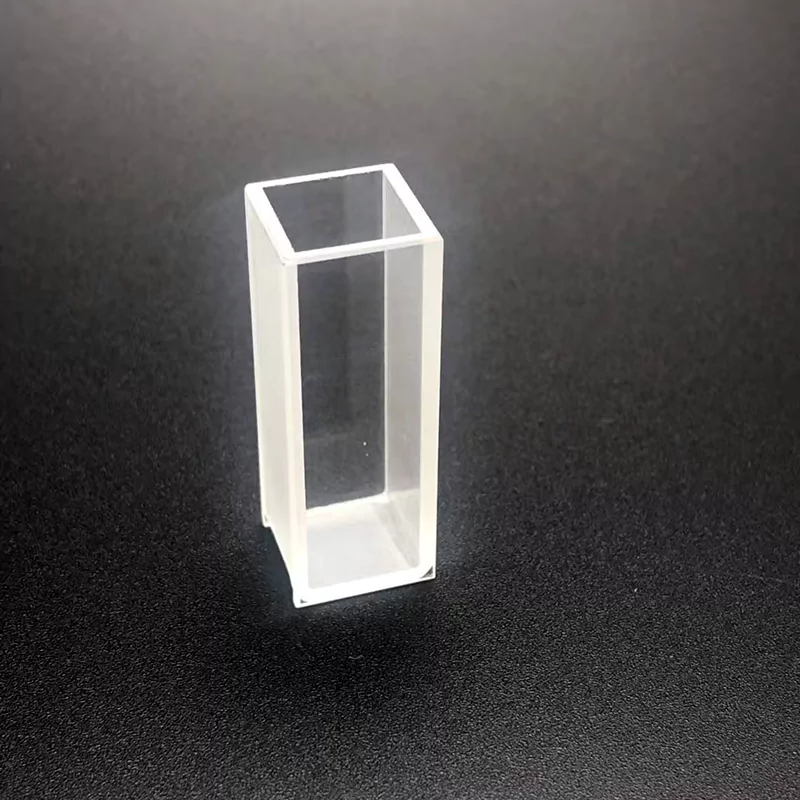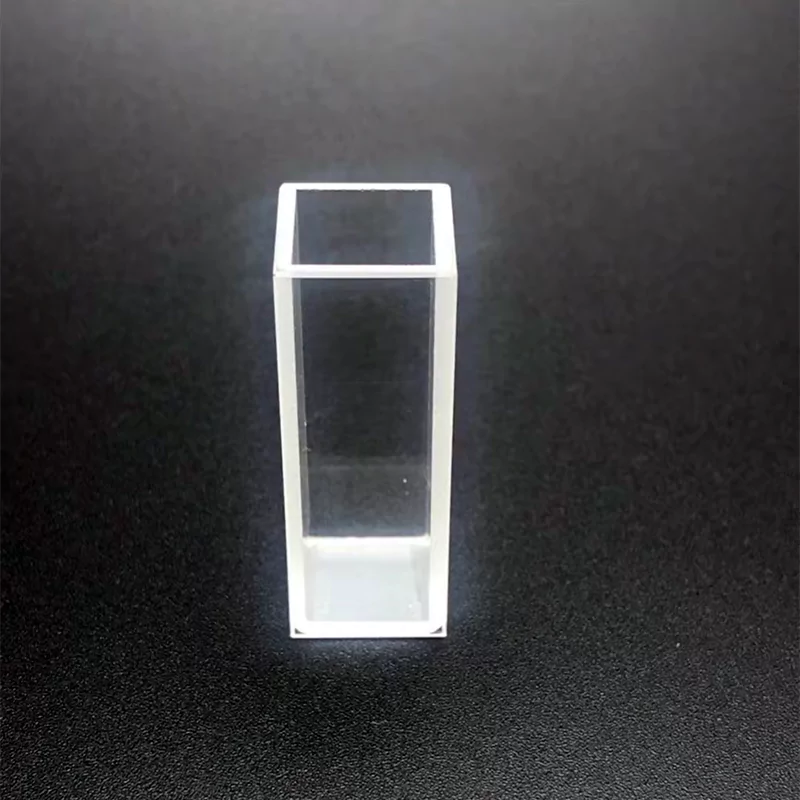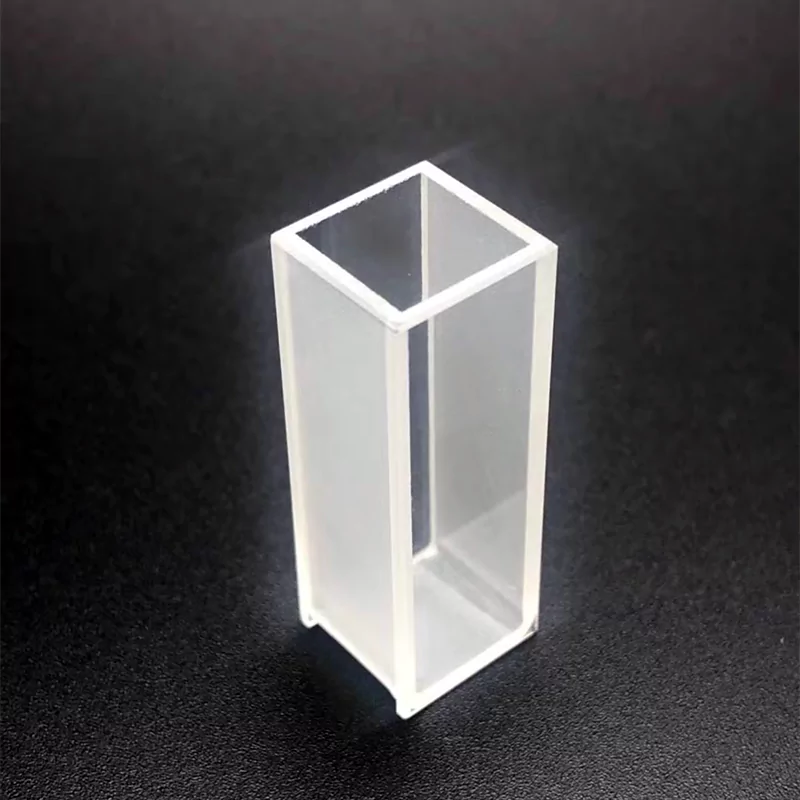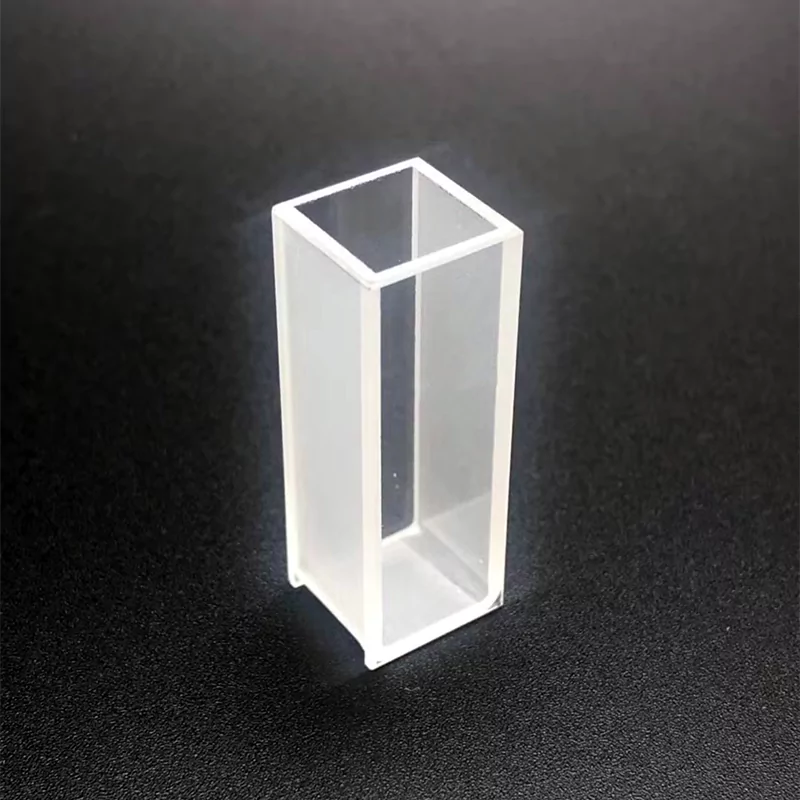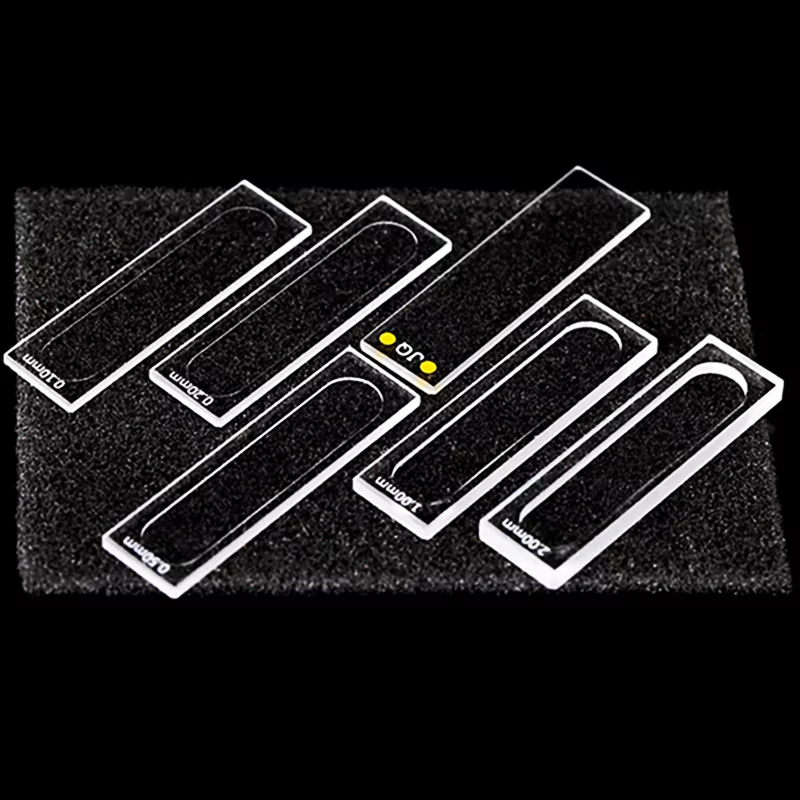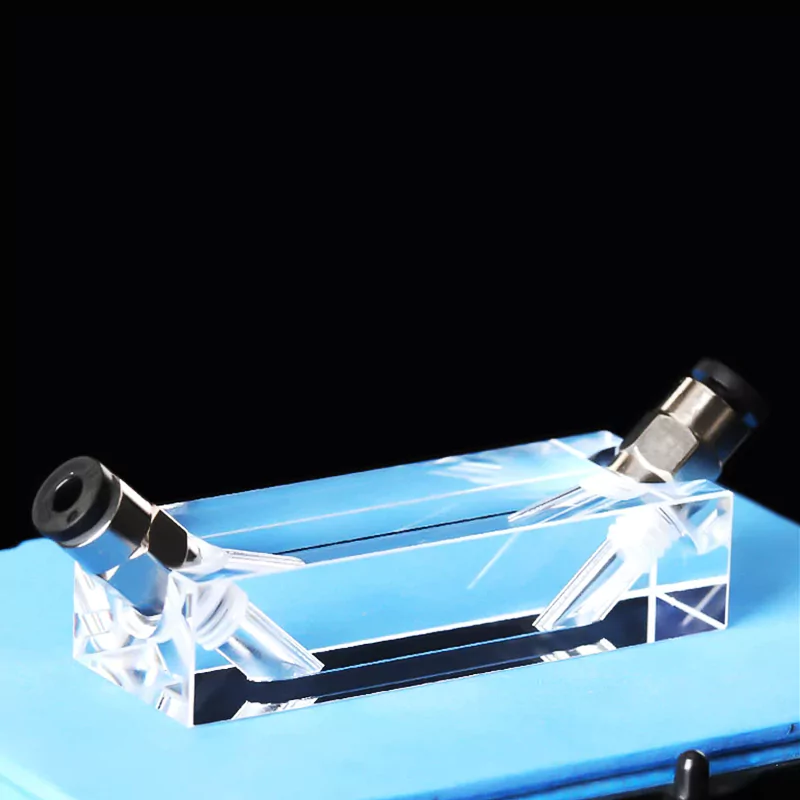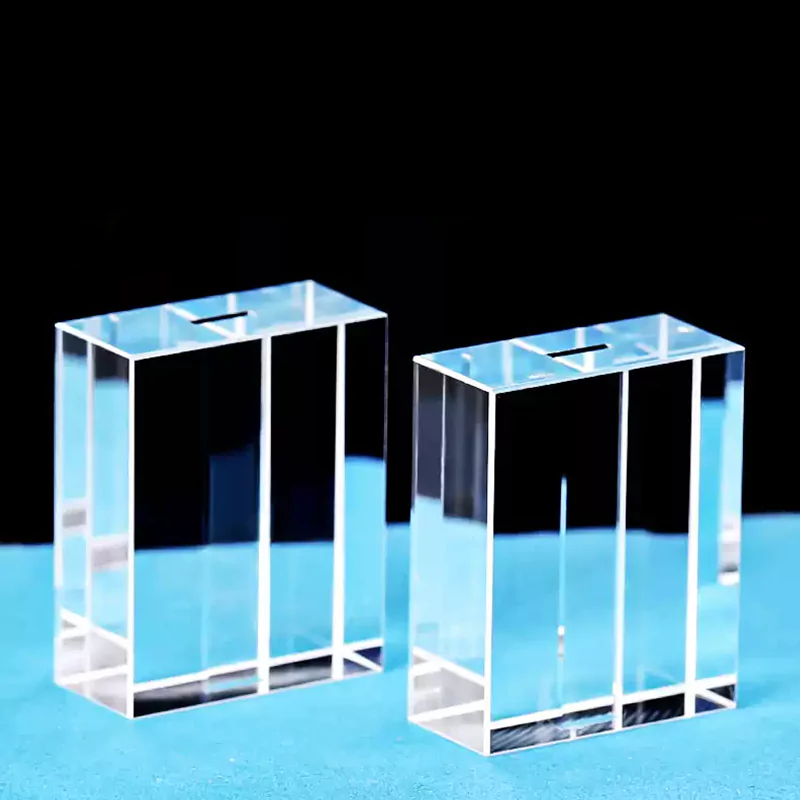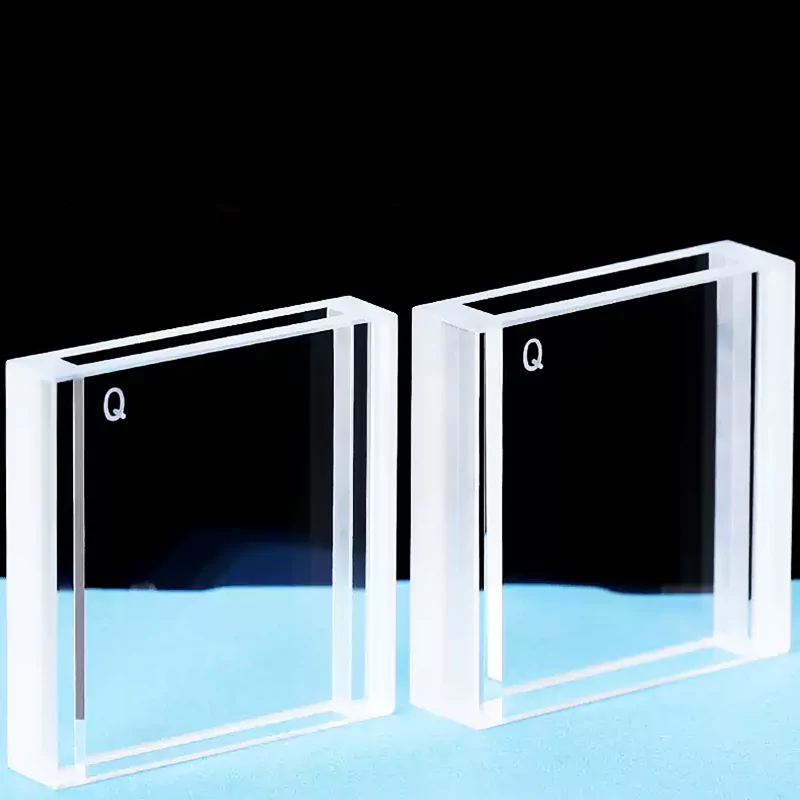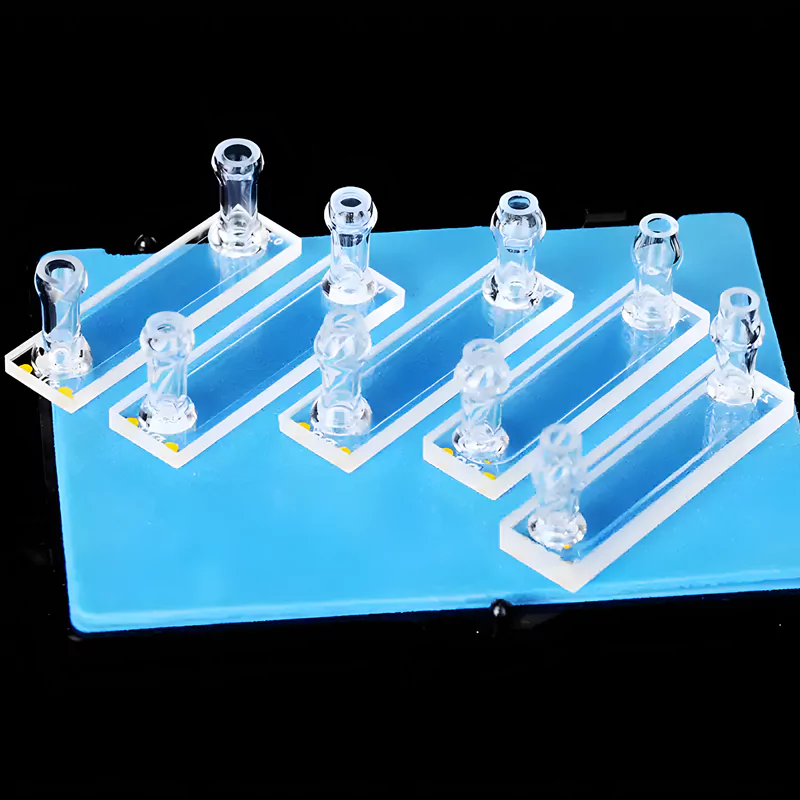- Home
- /
- Types
- /
- Quartz Cuvette
- /
- Quartz UV Cuvette
- /
- UV Standard Fused Quartz...
UV Standard Fused Quartz Cuvette Cell Level Bottom with Lid -TOQUARTZ®
Features 10mm path length, 3.5ml volume, and excellent transmission in 200-2500nm wavelength range. Ideal for laboratory analysis, pharmaceutical R&D, and environmental testing.
Features of UV Standard Quartz Cuvette Cell Level Bottom
TOQUARTZ® UV Standard Fused Quartz Cuvette Cells with Level Bottom and Lid are engineered from high-purity fused silica for precise spectroscopic analysis applications. These optical components deliver exceptional performance across the UV-Vis-NIR spectrum while maintaining chemical resistance and thermal stability.
Optical Properties
-
Wide Spectral Range
Excellent transmission from 200nm to 2500nm, ideal for UV-Vis-NIR spectroscopy applications with no absorption peaks throughout this range. -
Paired Testing
Each cuvette is tested for >80% transmittance with paired optical windows for consistent results in quantitative analysis. -
Precision Path Length
Standard 10mm optical path length with ±0.1mm tolerance for accurate absorbance measurements.
Design Features
-
Level Bottom Design
Flat bottom construction allows stable placement and consistent optical path for accurate spectroscopic measurements. -
Secure Lid
Fitted lid prevents sample evaporation and contamination during extended measurement periods. -
Polished Surfaces
Optically clear windows with high-quality polish (bubble-free, scratch-free) for optimal light transmission.
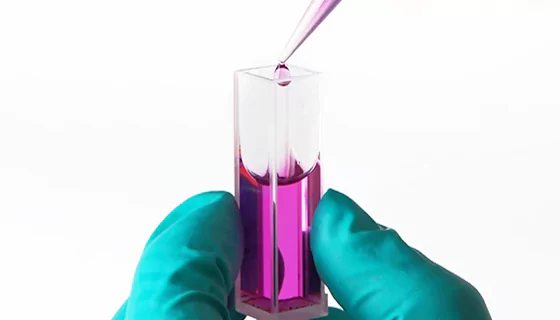
- Wide Spectral Range (200-2500nm)
- Thermal Stability (1100°C+)
- Custom Design Support
Technical Specifications & Dimensions of
Standard Fused Quartz Glass Cuvette Level Bottom
Technical Specifications of Standard Fused Quartz Cuvette UV Cell Level Bottom
Physical Properties
| Parameter | Value / Range | Unit / Notes |
| Material | Fused Quartz (≥99.995% SiO₂) | High-purity synthetic silica |
| Density | 2.2 | g/cm³ |
| Hardness (Mohs scale) | 5.5–6 | — |
| Young’s Modulus | 72 | GPa |
| Poisson’s Ratio | 0.17 | — |
| Compressive Strength | ≥1100 | MPa |
| Flexural Strength | ≥50 | MPa |
| Fracture Toughness | 0.8–0.9 | MPa·m½ |
| Thermal Conductivity | 1.3 | W/m·K (at 20°C) |
| Thermal Expansion Coefficient | 5.5 × 10⁻⁷ | /K (20–300°C) |
| Maximum Operating Temperature | 1100 | °C (continuous use) |
| Softening Point | 1665 | °C |
| Annealing Point | 1215 | °C |
| Strain Point | 1120 | °C |
| Path Length | 10.00 ± 0.10 | mm |
| External Dimensions | 12.5 × 12.5 × 45 | mm (W × D × H) |
| Internal Volume | 3.5 | ml |
| Wall Thickness Tolerance | ±0.10 | mm |
| Parallelism | ≤0.10 | mm |
| Lid Type | Flat lid or PTFE screw cap | Optional |
Chemical Properties
| Parameter | Value / Compatibility | Notes |
| Acid Resistance | Excellent | Except HF and hot H₃PO₄ |
| Alkali Resistance | Good | Avoid prolonged exposure to strong bases |
| Organic Solvent Resistance | Excellent | Compatible with alcohols, ketones, DMSO, etc. |
| Water Absorption | 0 | % |
| Surface Reactivity | Very Low | Inert to most chemical reagents |
| Autoclavable | Yes | With lid removed if plastic |
| Cleaning Compatibility | Compatible with dilute acids, detergents, ethanol | Avoid abrasive materials |
Optical Properties
| Parameter | Value / Range | Unit / Notes |
| Wavelength Transmission Range | 200 – 2500 | nm |
| UV Cutoff | 175 – 180 | nm |
| Transmittance @ 200nm | ≥80% | Paired testing |
| Transmittance @ 220–250nm | ≥85% | Typical |
| Transmittance @ 350–800nm | ≥90% | Typical |
| Refractive Index @ 546nm | 1.458 | — |
| Birefringence | None | Isotropic material |
| Absorbance Range (Recommended) | 0 – 3.0 | A (Absorbance Units) |
| Surface Quality | Scratch-free, bubble-free | Optical polish on 2 sides |
| Optical Windows | 2 sides polished, 2 sides frosted | Standard for UV-Vis cuvettes |
| Fluorescence Background | Negligible | Suitable for fluorescence spectroscopy |
Size of of Standard Fused Quartz UV Cuvette Level Bottom with Lid
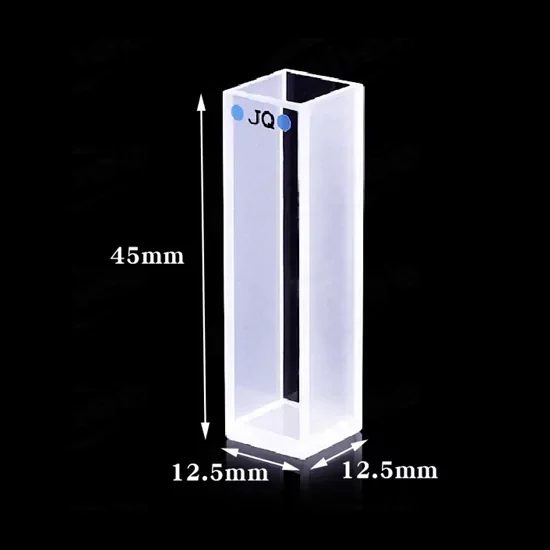
| Model | Description | Wavelength | Path Length | Volume | Transmittance | Outline Dimension |
| AT-BSM-056 | 3.5ml UV Standard Quartz Cuvette Cell Level Bottom with Lid | 200nm-2500nm | 10mm | 3.5ml | >80% (Paired Testing) | 12.5×12.5x45mm |
TOQUARTZ® Solving Analytical Challenges with
Standard Fused Quartz Round Bottom UV Cuvette
Standard Fused Quartz UV Cuvette Level Bottom in Pharmaceutical Research
Key Advantages
-
Consistent path length tolerance ±0.1mm
Ensures <1% deviation in absorbance for concentration-sensitive drug assays. -
UV transmission ≥85% @220nm
Enables accurate quantification of active pharmaceutical ingredients (APIs) in low-wavelength UV range. -
Acid-resistant fused quartz for formulation compatibility
Withstands repeated exposure to HCl, HNO₃, and organic solvents used in stability testing.
TOQUARTZ® solution
A US-based pharma lab reported 3.2% absorbance deviation using generic cuvettes in API quantification at 220nm.
TOQUARTZ® supplied cuvettes with certified ±0.1mm path length and ≥85% UV transmittance, reducing deviation to 0.6% and passing FDA validation.
Standard Fused Quartz UV Cuvette Level Bottom for Precision Instrument Manufacturing
Key Advantages
-
Dimensional repeatability within ±0.1mm across batches
Ensures seamless fit in automated sample changers. -
Optical window parallelism ≤0.1mm
Minimizes beam deviation during calibration of dual-beam spectrophotometers. -
12.5×12.5×45mm outer size with 3.5ml volume
Optimized for integration into compact benchtop UV-Vis instruments.
TOQUARTZ® solution
A German OEM faced 11% rejection rate due to cuvette misfit in auto-sampler trays. TOQUARTZ® delivered cuvettes with certified ±0.1mm tolerance and parallelism ≤0.1mm, reducing rejection to <1% and improving assembly efficiency.
Standard Quartz Cuvette UV Cell Level Bottom in Environmental Testing
Key Advantages
-
Surface durability under 100+ acid/base cleaning cycles
Maintains optical clarity after repeated exposure to 0.1M HNO₃ and NaOH. -
Stable transmittance after 6 months of high-throughput use
<2% drift in absorbance baseline after 500+ sample runs. -
Compatible with turbid water and soil extract matrices
No etching or fogging observed in samples with pH 3–11 and organic load.
TOQUARTZ® solution
A Canadian water lab replaced cuvettes every 3 months due to acid etching from daily HNO₃ cleaning.
TOQUARTZ® cuvettes retained >95% clarity after 6 months, cutting replacement frequency by 66% and saving $2,400/year.
Customization Services for TOQUARTZ®
Standard Quartz Glass UV Cuvette Level Bottom
Dimensional Customization
- Custom path lengths
- Non-standard external dimensions
- Modified internal volumes
- Special height requirements
- Micro-volume cuvette designs
Feature Modifications
- Screw cap options (PTFE or glass)
- Flow-through ports and tubing connections
- Graduated markings for volume indication
- Black-walled designs for fluorescence
- Custom optical window configurations
Specialty Applications
- High-temperature applications
- High-pressure measurement cells
- Compatible with specific instrument models
- Specialized flow cell designs
- Custom holder/adapter compatibility
TOQUARTZ® Customization Design Process
Requirement Analysis
TOQUARTZ® engineers begin by understanding your specific application needs for UV Standard Fused Quartz Cuvette Cell Level Bottom with Lid. This includes wavelength range, sample type, instrument compatibility, and volume constraints.
Technical Drawing Development
We create detailed CAD drawings of the customized cuvette, including lid type, path length, and external dimensions. All drawings are tailored to your UV-Vis spectroscopy setup and reviewed for feasibility.
Prototype Fabrication
A prototype of the custom UV Standard Fused Quartz Cuvette Cell Level Bottom with Lid is produced within 7–14 days. This allows you to validate fit, optical performance, and compatibility before mass production.
Optical and Dimensional Testing
Each prototype undergoes strict testing for path length accuracy (±0.1mm), UV transmittance (>80% @200nm), and dimensional tolerance. We ensure the cuvette meets your analytical precision requirements.
Batch Production and Delivery
Once approved, we proceed with batch manufacturing under ISO-level quality control. Your custom UV Standard Fused Quartz Cuvette Cell Level Bottom with Lid is delivered with full documentation and traceability.
Usage Guide of UV Standard Fused Quartz Cuvette Cell Level Bottom
Cleaning and Maintenance
-
Rinse immediately after use
Rinse with appropriate solvent compatible with your sample, followed by deionized water to prevent residue formation or sample cross-contamination. -
For thorough cleaning
Use mild detergent solution (1-2% laboratory-grade detergent), followed by multiple rinses with deionized water. For persistent residues, use dilute HCl (0.1M) or ethanol, avoiding concentrated acids (except HF, which should never be used). -
Drying methods
Air dry in a dust-free environment or rinse with acetone/ethanol for faster drying. For optical surfaces, use lens tissue or lint-free microfiber cloth. Avoid paper towels that can scratch optical surfaces. -
Storage recommendations
Store clean, dry cuvettes in original packaging or dedicated storage containers. Avoid direct contact between optical surfaces and hard materials that could cause scratches. -
Periodic inspection
Regularly inspect for scratches, chips, or residue buildup. Check optical clarity by holding against light source to identify potential issues before they affect measurements.
Proper Handling and Usage
-
Always handle by non-optical surfaces
Hold cuvettes by the frosted or ribbed sides, avoiding contact with optical windows to prevent fingerprints and contamination. -
Fill to appropriate level
Fill to approximately 2/3 capacity (about 3.0ml) to ensure the light path passes through the sample without interference from the meniscus. -
Position correctly in instrument
Align optical windows perpendicular to the light path with clear sides facing the beam direction. Note the orientation marks on cuvette sides. -
Secure lid before measurement
Use the provided lid to prevent evaporation and contamination, especially for volatile samples or extended measurement periods. -
Allow temperature equilibration
For temperature-sensitive measurements, allow cuvette and sample to reach thermal equilibrium before measurement (typically 2-3 minutes).
Solvent Compatibility Guide
| Solvent Type | Compatibility | Notes |
| Water (DI, tap, saline) | Excellent | No limitations |
| Alcohols (methanol, ethanol, isopropanol) | Excellent | No limitations |
| Acetone, acetonitrile | Excellent | No limitations |
| Most acids (HCl, H₂SO₄, HNO₃) | Good | Avoid prolonged exposure to concentrated acids |
| Bases (NaOH, KOH) | Good | Avoid prolonged exposure to concentrated bases |
| DMSO, DMF | Excellent | No limitations |
| Hydrofluoric acid (HF) | Not Compatible | Will etch and dissolve quartz |
| Hot phosphoric acid | Not Compatible | Will attack quartz at elevated temperatures |
Need Expert Guidance for Your UV Spectroscopy Applications?
customization options, and integration with your analytical instruments.
Whether you need standard products or custom solutions, we're ready to support your laboratory needs.
Why Partner with TOQUARTZ
Direct Factory Advantage
As a direct manufacturer, we can cut out the numerous intermediate links.
Engineering Expertise
Technical team guides clients from material selection to design optimization, translating specs into deliverables.
Flexible Manufacturing
Handling standard & custom orders via small-batch expertise and prototyping rigor to meet urgent deadlines.
Quality
Assurance
Pre-shipment 3-step validation:
1. dimensional accuracy,
2. material purity ,
3. performance thresholds
Global Supply Chain
Reliable global logistics to industrial hubs (DE/US/JP/KR priority) with trackable milestones.
Releted Products
As a specialized manufacturer with direct factory capabilities, TOQUARTZ provides both standard and custom quartz solutions with engineering support throughout the specification and implementation process.
FAQ
Q: Why are UV Standard Fused Quartz Cuvette Cell Level Bottom with Lid used in UV spectroscopy?
A: Fused quartz cuvettes Cuvettes Level Bottom with Lid are essential for UV spectroscopy because they provide exceptional transparency in the ultraviolet region (down to 200nm), unlike regular glass which absorbs UV light. The high-purity quartz material (max. up to 99.995% SiO₂) ensures minimal interference with measurements, while the standardized dimensions (particularly the precise 10mm path length) enable accurate and reproducible quantitative analysis across different instruments. The level bottom and lid further improve measurement stability and sample integrity.
Q: What is the wavelength range of Standard Quartz UV Cuvettes Level Bottom with Lid?
A: TOQUARTZ® Standard Quartz UV Cuvettes Cuvettes Level Bottom with Lid provide excellent transmission from 200nm to 2500nm, covering the ultraviolet, visible, and near-infrared regions of the spectrum. This broad range makes them suitable for diverse spectroscopic applications, from UV absorbance of proteins and nucleic acids to visible colorimetric assays and even some NIR applications. The transmittance at 200nm exceeds 80%, which is critical for sensitive UV measurements.
Q: What are the common applications for Standard Quartz UV Cuvettes Cuvettes Level Bottom with Lid?
A: Standard Quartz UV Cuvettes Cuvettes Level Bottom with Lid are widely used in numerous applications, including: protein and nucleic acid quantification in molecular biology; pharmaceutical drug development and quality control; environmental water quality monitoring; chemical concentration determination; kinetics studies of chemical reactions; food and beverage quality analysis; forensic sample testing; clinical diagnostics of biological samples; materials science research; and educational laboratory demonstrations. Their versatility stems from excellent UV transmission properties, chemical resistance, and dimensional precision, making them essential tools across scientific disciplines where spectroscopic analysis is required.
Q: What are the Standard Quartz UV Cuvette Cuvettes Level Bottom with Lid direction considerations?
A: Proper orientation of Standard Quartz UV Cuvettes Cuvettes Level Bottom with Lid is crucial for accurate measurements. The cuvette should be placed so that the transparent optical windows face the light path, while the frosted or ribbed sides are perpendicular to the beam. Most spectrophotometers have a fixed light path direction, and our cuvettes feature orientation marks to ensure correct placement. For our standard two-window cuvettes, the polished optical windows should face the incident light beam and detector. Incorrect orientation could result in light passing through the non-optical sides, causing scattering and measurement errors. Always refer to your instrument’s manual for specific cuvette orientation requirements.
Q: What is the Standard Quartz UV Cuvette Cuvettes Level Bottom with Lid absorbance range?
A: The practical absorbance range for our Standard Quartz UV Cuvettes Cuvettes Level Bottom with Lid is typically 0 to 3.0 absorbance units (A). For most accurate results, measurements are recommended in the 0.1-1.0 A range, where the relationship between concentration and absorbance is most linear according to the Beer-Lambert Law. Beyond 2.0 A, precision may decrease due to reduced light reaching the detector. For samples with higher absorbance, we recommend either dilution or using cuvettes with shorter path lengths (available in our custom offerings). Our cuvettes are tested to ensure minimal intrinsic absorbance, providing a clean baseline for accurate sample measurements.
Contact our engineering team for technical consultation and pricing. We’ll help you select the optimal specifications for your application requirements.

